
There is no activity for which young children are better prepared than fantasy play. Nothing is more dependable and risk-free, and the dangers are only pretend’ – Vivian Gussin-Paley, 2004.
Fantasy play is the ‘glue that binds together all other pursuits’, including the early teaching of reading and writing skills, according to Ms Gussin-Paley, teacher, writer and advocate for the importance of children’s play. It is in the development of their themes, characters and plots that children explain their thinking, she continues in her book A Child’s Work: The Importance of Fantasy Play.
Whether the child is crawling under the table meowing and woofing in secret communication, dabbling with wizardry in the mud kitchen or saving the day as Bat Girl, it is through this form of play that children can explore themes of good and bad, kindness and cruelty and hope and fear. It is our role as practitioners to observe the children’s play and enter, where appropriate, as a minor character to model language and behaviour.
WHAT IS FANTASY PLAY? 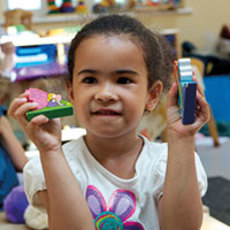
In fantasy play, children learn to envision new roles for themselves and for other people. They learn to change and redirect the outcome of an imaginary plot and to include the ideas of others in their plans. Dramatisation is an essential piece of the process.
In an interview with the American Journal of Play in 2009, Ms Gussin-Paley describes the importance of fantasy play in early childhood, ‘If a little girl is asked, for example, “How do you like your new baby brother?” it is hard for her to imagine what the question means and what answer she ought to give in response. However, if she transposes the question into “How does Goldilocks feel about Baby Bear?” she can imagine an entire scenario and even involve her playmates in a consideration of various aspects of the issues concerning big sisters and little siblings. Fantasy play provides easy entree into abstract thinking and sets up patterns of “what if” and “in other words” that become a model for discussions on all subjects.’
THE ROLE OF THE PRACTITIONER
Stepping into fantasy play scenarios requires sensitivity and confidence, according to early years consultant, author and trainer Anni McTavish.
She says, ‘Some practitioners might have had limited experience of fantasy play in their own lives, so may struggle to feel comfortable with this type of play. Others might not agree with fantasy play per se and some settings may prefer to redirect or stop fantasy play if they are not comfortable with some of the themes – for example, death or superheroes. However, it’s important to note that children bring into their play important themes that they are exploring and need to process.’
She continues, ‘A sensitive adult will wait for the right moment to join in, or wait for the invitation to join in from the child or children. They can start in small ways, adding language, and commentating, rather than asking questions, which can interrupt the flow of the play. Providing props and materials can support play to continue, or indeed begin.
‘The adult can then provide an appropriate “model” for the fantasy play. For example, “I am the squelch monster, and can only eat mud for dinner!” Of course, this depends on the game or fantasy play that is going on, so picking up on the children’s cues, ideas and suggestions is crucial.’
CORE COLLECTION
Building up a core collection of resources that enable children to act out fantasy play scenarios is vital. For example, a variety of open-ended resources such as pieces of fabric, junk-modelling materials, cardboard boxes and blocks can enable children to role-play characters and make their own accessories.
Free-range access to items across the nursery can enhance the play, along with well-trained adults who know the child really well and can attune to his or her play.
RESOURCES
Below is a list of key resources for a fantasy play collection:
- Open-ended resources, both indoors and out, can support fantasy play.
- Inspiring books: story books and information books about all sorts of different experiences, roles and imaginative experiences, with adults taking time to read and tell stories, can provide a diet rich in ideas and imagination and offer new experiences.
- New artefacts, links to historical stories or events.
- Outings, events, visitors or theatrical experiences.
- Puppets and small-world play.
Role play 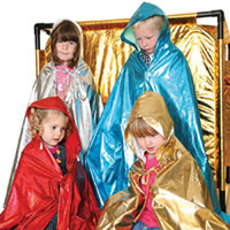
- Provide hats; bags; shawls; cloaks; fabrics such as velvet, muslin, silk, gold lame; wings; magic wands; magic carpet; magic chair; pot for magic porridge or making spells; spell ingredients: bubble mixture, sequins, glitter and coloured water.
- Try the Role Play Dressing Up Glitter Cloaks, £39.95, from www.tts-group.co.uk/role-play-dressing-up-glitzy-cloaks-3pcs/1000591.html; or the Role Play Astronaut Dressing Up Suit, £27.95, from www.tts-group.co.uk/role-play-astronaut-dressing-up-suit/1000863.html; and keep your dressing-up props tidy with this colourful Role Play Wooden Dressing Up Trolley, £159.95, from www.tts-group.co.uk/role-play-wooden-dressing-up-trolley/1005925.html.
- For fiery fun and frolics, try the set of 3 Dragon Capes, £29.95, or make your own costumes using the Organza Rolls, 3pk, £12.49, or the Black Sequinned Net, £2.99 – all from www.cosydirect.com.
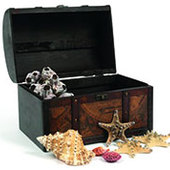
- Early Excellence supplies a range of cloaks including the Wizard Cape and Hat, £24.95, and the Royal Cape and Crown, £24.95, available at http://earlyexcellence.com/go-shopping/royal-cape-and-crown.
- Reflections on Learning (www.reflectionsonlearning.co.uk) has a package of props for would-be pirates, including the Pirate Telescope, £3.99, Treasure Box, £21.99, and Gemstones, £7.99.
- Let children’s imaginations soar in the Role Play Wooden Woodland Play Loft, built on two levels – priced £1,349.95 and available at www.tts-group.co.uk/role-play-wooden-woodland-play-loft/1009852.html.
- Open the door to children’s fairytales with the Fairy Child Door, £110, from www.cosydirect.com/fairy-child-door.html.
Small-world play 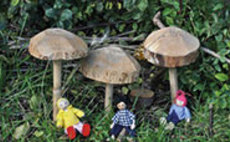
Small-world play can provide a wonderful gateway for imaginary play. Using the simplest of resources, children can create exciting worlds full of knights, dragons, fairies and wizards. Children will make up stories for their new characters, practising essential narrative skills and descriptive language. Often there will be strong links with home life, whether it is a favourite fairytale book or a popular film, such as Disney’s Tangled.
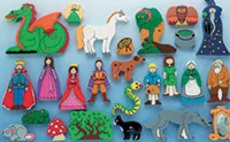 Offer a selection of small-world play figures in the form of knights, wizards and dragons, princesses, queens and kings, and horses. Try the Fantasy World Wooden Characters (£50 for a set of 25) from www.yellow-door.net, or the Schleich or Papo fantasy figurines, available from various retailers or at www.toysandlearning.co.uk.
Offer a selection of small-world play figures in the form of knights, wizards and dragons, princesses, queens and kings, and horses. Try the Fantasy World Wooden Characters (£50 for a set of 25) from www.yellow-door.net, or the Schleich or Papo fantasy figurines, available from various retailers or at www.toysandlearning.co.uk.
For a small-world fairy garden, try the Fantasy World Toadstools, £16.99, from www.cosydirect.com or the Fairy Folk Wooden Characters, £30, with the Stacking Fairy House, £8, from www.yellow-door.net.
CASE STUDY: ROBERT OWEN, GREENWICH
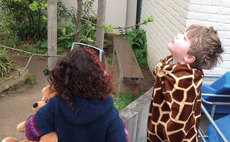 Samantha Beer, early years practitioner at Robert Owen Nursery School and Children’s Centre in Greenwich, London, has been supporting three-year-old Hugo with his fantasy of becoming an animal.
Samantha Beer, early years practitioner at Robert Owen Nursery School and Children’s Centre in Greenwich, London, has been supporting three-year-old Hugo with his fantasy of becoming an animal.
She says, ‘Hugo announced that he was Baker the puppy, which was triggered by a member of staff talking with him about a new puppy. During the week, he was taught to sit, roll, lie, beg and give a paw. He drank some water out of a bowl and enjoyed being patted and following key staff around the nursery garden.’
Hugo needed no props for this form of fantasy play, just some caring adults who served as a rich resource. With security and confidence, he knew that he could be whatever he wanted to be and that his needs would be met.
The next week, Hugo decided to become a giraffe. The interest came when he discovered a simple piece of giraffe print fabric which he wrapped himself up in. Ms Beer talked to him about how giraffes move, with their long legs and tall necks. While Ruth, the head teacher, was in the garden with consultant Anni McTavish, she felt a ‘hoof’ pawing her. She turned and there was Hugo the giraffe. He said he was hungry and went off to search for leaves. Ruth took the leaves and encouraged him to stretch up with his neck to reach them.
Ms Beer says, ‘Hugo has a tremendous and successful drive to engage adults positively in his play. The giraffe decided he wasn’t keen on leaves and declared, “Giraffes like apple”. He sourced some apple pieces quickly from a snack table and adults fed him from a height, to encourage the stretch of his neck.’
She adds, ‘He was informed that giraffes have no voice and was promptly silent for the rest of the session.’
MORE INFORMATION
Gussin-Paley, V (2004) A Child’s Work: The Importance of Fantasy Play. The University of Chicago Press









